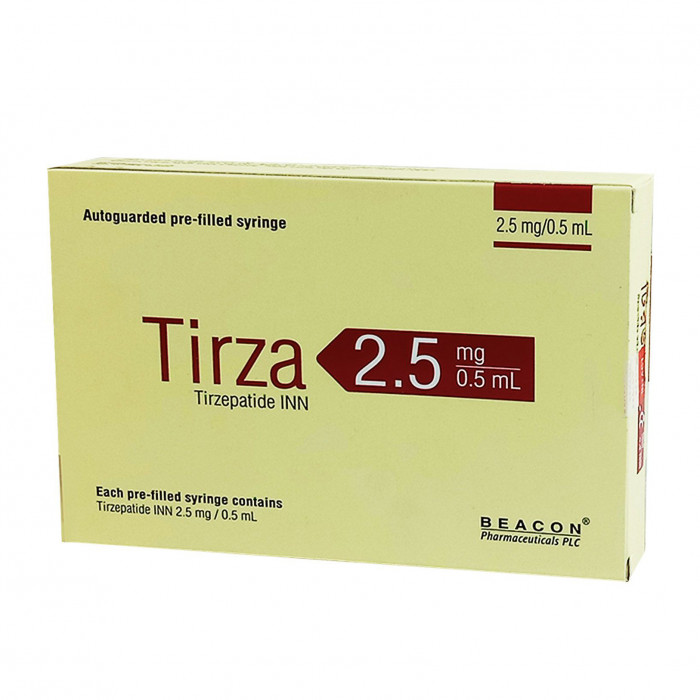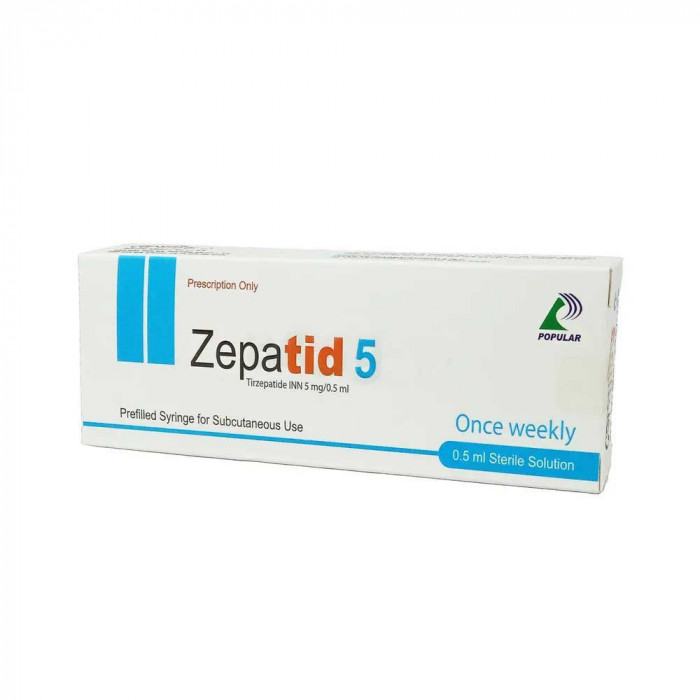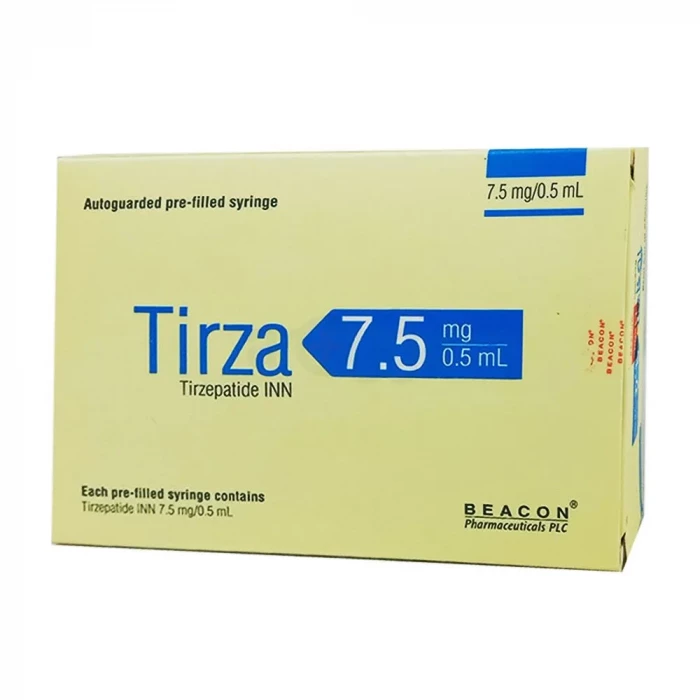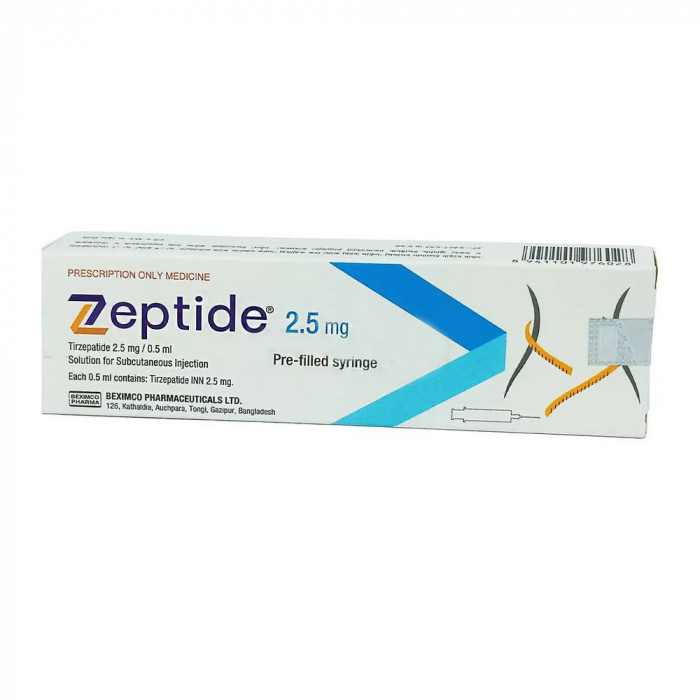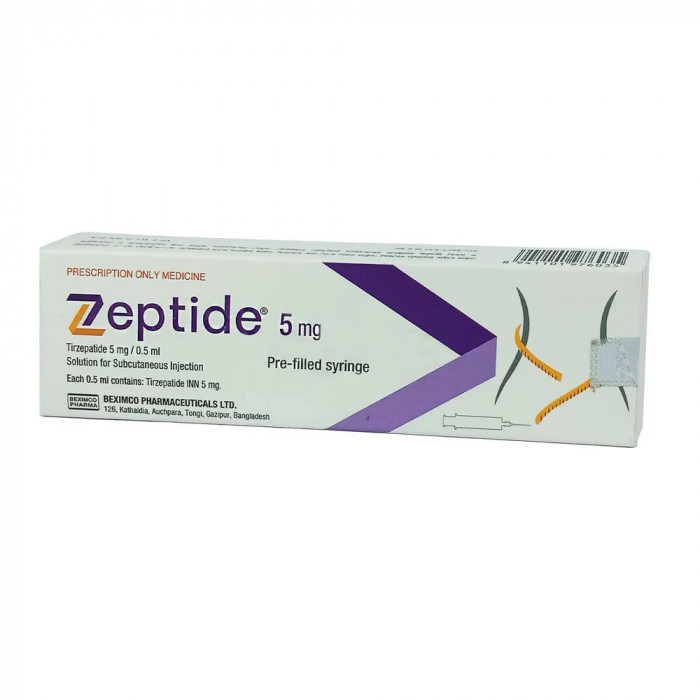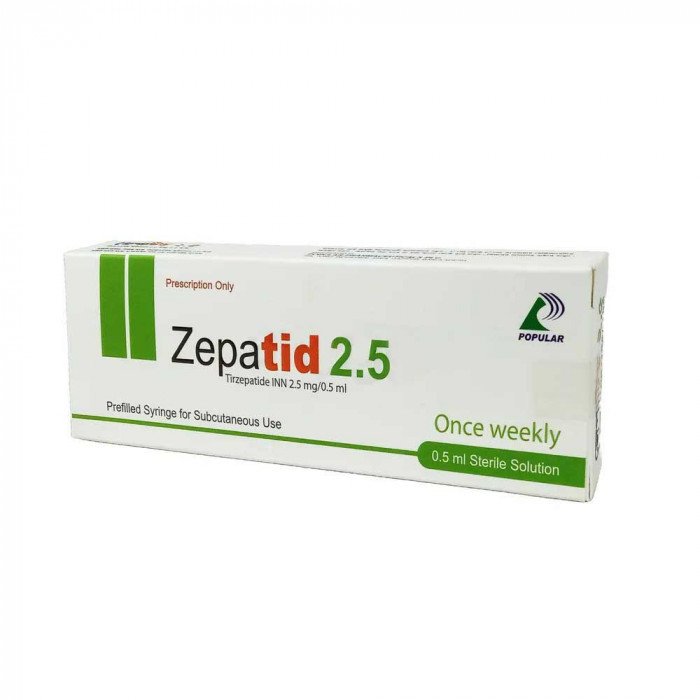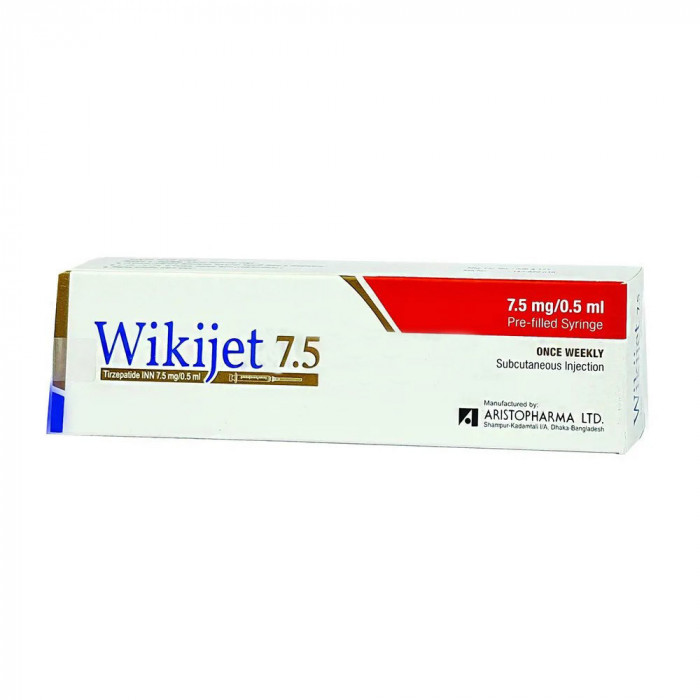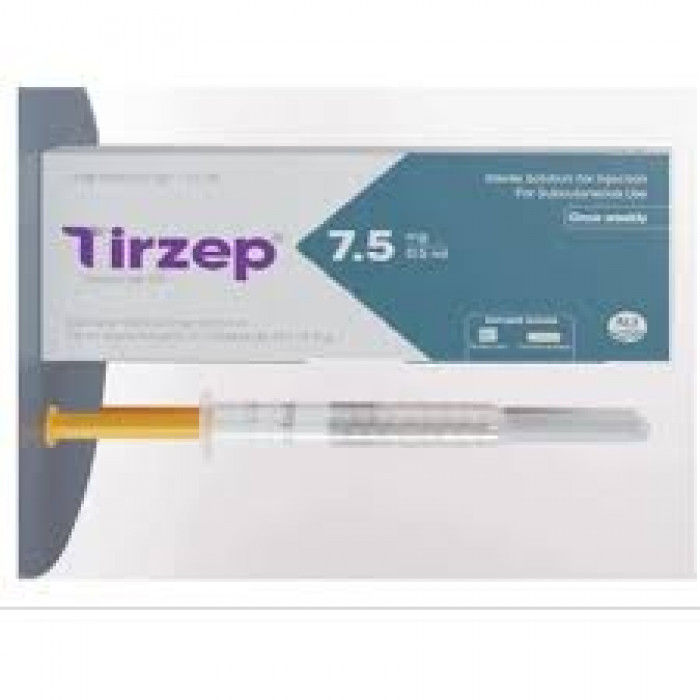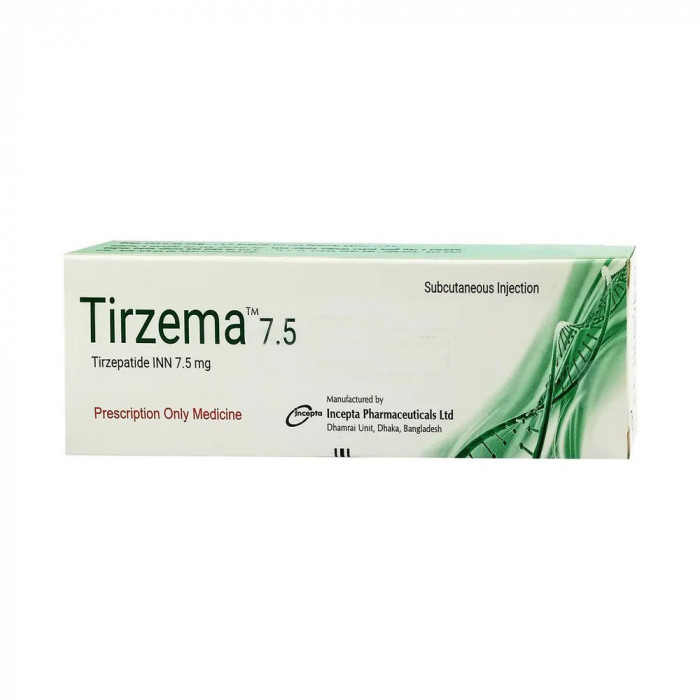
✔ 100% Authentic Product
👁️ Currently Viewing 4257
Tirzema 7.5mg Pre-Filled Syringe
Tirzema is prescribed as an adjunct to diet and exercise for improving glycemic control in adults with type 2 diabetes mellitus.
Limitations of Use:
- It has not been studied in patients with a history of pancreatitis.
- It is not intended for use in patients with type 1 diabetes mellitus.
Discount
Price: ৳ 2,660
MRP:
৳
2800
5%
Off

100% Genuine Products, Guaranteed

Safe & Secure Payments, Always

Fast, Secure & Efficient Delivery

Proper Packaging
 Cash on Delivery - All over Bangladesh
Cash on Delivery - All over Bangladesh Regular Delivery - 12-24 Hours, Dhaka City* Charge Tk.39-59
Regular Delivery - 12-24 Hours, Dhaka City* Charge Tk.39-59 Regular Delivery - 24-48 Hours, Other Cities* Charge Tk.99-110
Regular Delivery - 24-48 Hours, Other Cities* Charge Tk.99-110
 ফ্রি ডেলিভারিঃ - ৯৯৯ টাকা+ অর্ডারে, ঢাকা
শহরে
ফ্রি ডেলিভারিঃ - ৯৯৯ টাকা+ অর্ডারে, ঢাকা
শহরে ফ্রি ডেলিভারিঃ - ২৯৯৯ টাকা+ অর্ডারে, ঢাকার
বাহিরে
ফ্রি ডেলিভারিঃ - ২৯৯৯ টাকা+ অর্ডারে, ঢাকার
বাহিরে
100% Genuine Products, Guaranteed
Safe & Secure Payments, Always
Fast, Secure & Efficient Delivery
Proper Packaging
 Cash on Delivery - All over Bangladesh
Cash on Delivery - All over Bangladesh Regular Delivery - 12-24 Hours, Dhaka City* Charge Tk.39-59
Regular Delivery - 12-24 Hours, Dhaka City* Charge Tk.39-59 Regular Delivery - 24-48 Hours, Other Cities* Charge Tk.99-110
Regular Delivery - 24-48 Hours, Other Cities* Charge Tk.99-110 ফ্রি ডেলিভারিঃ - ৯৯৯ টাকা+ অর্ডারে, ঢাকা
শহরে
ফ্রি ডেলিভারিঃ - ৯৯৯ টাকা+ অর্ডারে, ঢাকা
শহরে ফ্রি ডেলিভারিঃ - ২৯৯৯ টাকা+ অর্ডারে, ঢাকার
বাহিরে
ফ্রি ডেলিভারিঃ - ২৯৯৯ টাকা+ অর্ডারে, ঢাকার
বাহিরে
✅ Description:
Tirzema contains tirzepatide, a dual agonist that activates both GIP (Gastric Inhibitory Polypeptide) and GLP-1 (Glucagon-like Peptide-1) receptors. This 39-amino-acid modified peptide has a C20 fatty diacid moiety that allows it to bind with albumin, which helps prolong its half-life in the body.
Tirzepatide enhances insulin secretion (both first and second) and reduces glucagon levels, both in a glucose-dependent manner, meaning these effects are more pronounced when blood sugar levels are high. It plays a significant role in regulating glucose metabolism and improving glycemic control.
✔️
✔️ Dosage & Administration
Route of Administration: Tirzema is administered as a subcutaneous injection.
- Starting dose: Begin with 2.5 mg once weekly. This initial dose is for treatment initiation and is not intended for immediate glycemic control.
- After 4 weeks, increase the dosage to 5 mg once weekly.
- If further glycemic control is needed, increase the dose by 2.5 mg increments every 4 weeks. The maximum dosage is 15 mg once weekly.
✔️ Injection Schedule:
The weekly injection day can be changed as long as there is at least a 3-day (72-hour) gap between doses.
✔️ Missed Dose:
If a dose is missed, patients should administer it within 4 days (96 hours) of the missed dose. If more than 4 days have passed, skip the missed dose and continue with the next scheduled dose.
✔️ Overdose Effects
In the event of an overdose, supportive treatment should be administered based on the patient's symptoms. Because the half-life of Tirzema is approximately 5 days, patients may need to be observed and treated accordingly.
✔️ Children and Adolescents:
The safety and efficacy of Tirzema in patients under 18 years of age have not been established.
✔️ The most common side effects associated with Tirzema include:
- Nausea
- Diarrhea
- Decreased appetite
- Vomiting
- Constipation
- Dyspepsia (indigestion)
- Abdominal pain
✔️ Injection Sites:
Inject subcutaneously into the abdomen, thigh, or upper arm. Rotate the injection sites with each dose. If using insulin concurrently, administer the injections separately and never mix them.
✔️ Preparation and Administration:
- The pre-filled syringe contains dry natural rubber (a latex derivative), which may cause allergic reactions.
- Do not freeze. Only use tripeptide that has not been frozen.
- Protect pre-filled syringes from light.
- Before administration, visually inspect the syringe for particulate matter or discoloration. Do not use if either is present.
- Handle the syringe with care—if it drops, do not use it.
- Do not dilute tripeptide, and do not mix it with other drug solutions.
✔️ Drug Interactions
- Insulin Secretagogues: If using insulin secretagogues (like sulfonylureas) alongside Tirzema, consider reducing the dose of these medications to reduce the risk of hypoglycemia.
- Tirzema delays gastric emptying, which can affect the absorption of other oral medications. Be cautious with oral medications that rely on threshold concentrations for efficacy, such as warfarin.
- For patients using oral hormonal contraceptives, switch to a non-oral contraceptive method or use a barrier method for 4 weeks after initiation and after each dose escalation. Non-oral contraceptives are unaffected.
✔️ Tirzema should not be used in patients who:
- Have a known hypersensitivity to tirzepatide or any other components of the product.
- Have a personal or family history of medullary thyroid carcinoma (MTC) or multiple endocrine neoplasia syndrome type 2 (MEN 2).
✔️ Pregnancy & Lactation
- Tirzema should be used during pregnancy only if the potential benefits justify the risks to the fetus. Poorly controlled diabetes can pose significant risks to both the mother and the fetus.
- The use of Tirzema during lactation should be carefully considered, weighing the benefits of breastfeeding against any potential adverse effects on the infant.
✔️ Precautions & Warnings
- Risk of MTC: Patients should be informed about the risk of medullary thyroid carcinoma (MTC) and be aware of the symptoms of thyroid tumors.
- Pancreatitis: Monitor for signs of pancreatitis. If symptoms occur, discontinue Tirzema and provide appropriate treatment.
- Hypoglycemia: Adjust insulin secretagogues or insulin doses to reduce the risk of hypoglycemia.
- If there is a history of diabetic retinopathy, monitor for progression of the condition.
- If cholelithiasis (gallstones) is suspected, follow up with diagnostic studies and clinical care.
✔️ Storage Conditions
- Refrigerate between 2°C to 8°C.
- Do not freeze. Protect from light.
- Keep out of the reach of children and use only with a prescription from a registered healthcare provider.
⚠️Disclaimer:
At ePharma, we’re committed to providing accurate and accessible health information. However, all content is intended for informational purposes only and should not replace medical advice from a qualified physician. Please consult your healthcare provider for personalized guidance. We aim to support, not substitute, the doctor-patient relationship.




